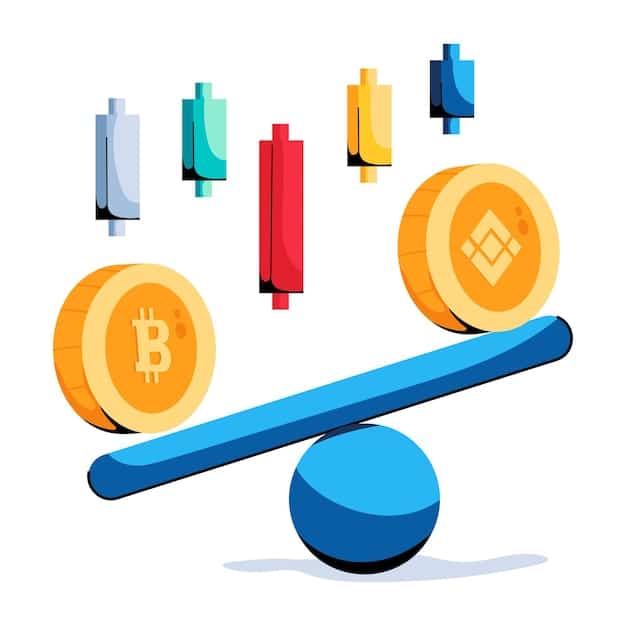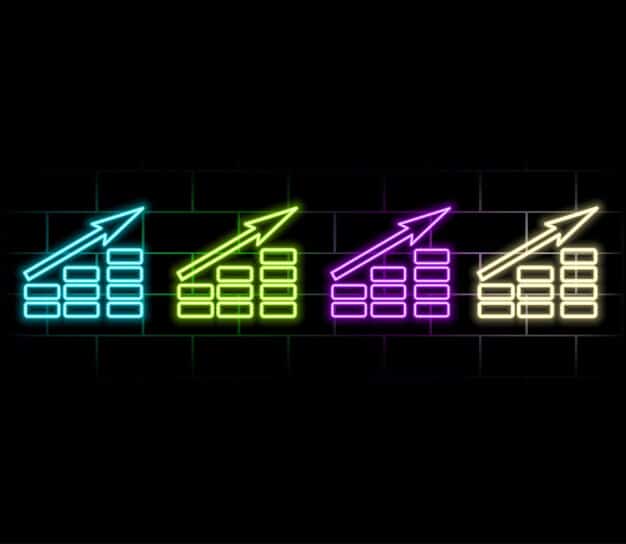Portfolio Diversification in DeFi: Balancing Risk & Reward on Solana for US Investors

Portfolio diversification in DeFi, specifically on Solana for US investors, involves strategically allocating capital across various decentralized finance assets to manage risk and optimize returns. It requires understanding the unique opportunities and challenges within the Solana ecosystem.
Portfolio Diversification in DeFi: Balancing Risk and Reward on Solana for US Investors is crucial for navigating the volatile crypto landscape. This guide provides a comprehensive overview of how US investors can effectively diversify their DeFi portfolios within the Solana ecosystem to mitigate risk and enhance potential returns.
Understanding DeFi and Solana
Decentralized Finance (DeFi) offers innovative financial services like lending, borrowing, and trading without traditional intermediaries. Solana, a high-performance blockchain, provides a fertile ground for DeFi applications due to its speed and low transaction costs.
What is DeFi?
DeFi leverages blockchain technology to create open, permissionless, and transparent financial systems. These systems aim to replicate traditional financial services but in a decentralized manner.
Why Solana for DeFi?
Solana distinguishes itself through its high throughput and low fees, making it an attractive platform for DeFi projects. Its unique architecture allows for faster transaction processing, enhancing user experience and scalability.

Solana’s rise in the DeFi space can be attributed to its technological advantages, which support more complex and frequent transactions. This efficiency enables a broader range of financial applications and user participation. Solana has gained prominence in the DeFi space due to its scalability and lower transaction costs compared to other blockchains.
- Scalability: Solana’s architecture ensures high transaction throughput.
- Low Fees: Reduced transaction costs make it more accessible.
- Fast Transactions: Quick processing times enhance user experience.
Solana’s ecosystem is continuously evolving, with new projects and opportunities emerging regularly. This dynamic landscape presents both opportunities and challenges for investors seeking to diversify their DeFi portfolios.
In summary, Solana’s advanced features make it a prime platform for DeFi, offering US investors a dynamic environment to diversify their portfolios. Understanding these basics is essential for crafting a successful DeFi investment strategy.
The Importance of Portfolio Diversification in DeFi
Diversification is a fundamental principle in investing, applicable to both traditional finance and the burgeoning world of DeFi. It involves spreading investments across different assets to mitigate the impact of any single investment’s poor performance.
Reducing Risk Through Diversification
In the volatile DeFi market, diversification acts as a safety net. By allocating funds across various DeFi protocols and assets, investors can reduce their exposure to specific project failures or market downturns.
Maximizing Potential Returns
Diversification not only minimizes risk but also positions investors to capture gains from various sectors within the DeFi ecosystem. Different assets may perform well at different times, ensuring a more stable and potentially higher overall return.
Diversification is crucial for managing risk and enhancing returns in any investment strategy which includes DeFi. The main goal is protecting the capital and profiting from a wider range of opportunities available in the DeFi space.
- Mitigate Losses: Spreading investments reduces the impact of individual asset failures.
- Capture Gains: Exposure to multiple assets increases the likelihood of benefiting from market trends.
- Stable Returns: A balanced portfolio can provide more consistent performance over time.
Effective diversification requires careful research and understanding of the different DeFi assets and their risk profiles. It’s essential to assess the correlation between different assets to ensure they don’t all move in the same direction.
In conclusion, diversification is a vital strategy for US investors in DeFi, offering a balanced approach to managing risk and maximizing potential returns. It allows for a more resilient and adaptable portfolio in the ever-changing DeFi landscape.
DeFi Opportunities on Solana for US Investors
Solana’s ecosystem presents a multitude of DeFi opportunities for US investors, ranging from yield farming to decentralized exchanges (DEXs) and staking. Each opportunity offers unique risk-reward profiles.
Yield Farming
Yield farming involves providing liquidity to DeFi protocols in exchange for rewards, typically in the form of governance tokens or a share of transaction fees. On Solana, platforms like Raydium and Orca offer attractive yield farming opportunities.
Decentralized Exchanges (DEXs)
DEXs allow users to trade cryptocurrencies directly without intermediaries. Platforms like Serum, built on Solana, provide fast and efficient trading experiences. Liquidity pools within DEXs offer another avenue for earning passive income.
Solana’s DeFi ecosystem has a wide array of options for investors. The proper usage of these opportunities requires understanding the protocols involved and their risks.

- Lending and Borrowing: Platforms like Solend and Mango Markets allow users to lend and borrow assets.
- Staking: Staking Solana (SOL) or other tokens on the network helps secure the blockchain and earns rewards.
- NFTs and DeFi: Integrating NFTs into DeFi protocols opens new avenues for investment and earning.
Before participating in any DeFi protocol, US investors should conduct thorough research on the platform’s security, liquidity, and regulatory compliance. Diversifying across multiple protocols can further mitigate risk.
In summary, Solana offers a rich selection of DeFi opportunities for US investors, each with its own set of risks and rewards. Diligence and diversification are key to navigating this dynamic landscape successfully.
Assessing Risk in Solana DeFi Investments
While Solana’s DeFi ecosystem offers attractive opportunities, it’s crucial for US investors to understand and assess the associated risks. These risks range from smart contract vulnerabilities to impermanent loss and regulatory uncertainty.
Smart Contract Risks
Smart contracts are the backbone of DeFi protocols, but they are not immune to bugs or vulnerabilities. Exploits can lead to loss of funds, making it imperative to invest in protocols with audited and verified smart contracts.
Impermanent Loss
Impermanent loss occurs when the price of tokens in a liquidity pool diverges, resulting in a temporary loss compared to holding the tokens outside the pool. Understanding the dynamics of impermanent loss is essential for liquidity providers.
Risk assessment is extremely important for protecting investments and maximizing profit. An ideal risk management strategy can significantly improve outcomes in the DeFi market.
- Regulatory Risks: The regulatory landscape for DeFi is still evolving, and changes in regulations could impact the legality or viability of certain protocols.
- Liquidity Risks: Low liquidity can lead to slippage and difficulty in exiting positions, especially in volatile market conditions.
- Platform Risks: Each DeFi platform carries its own set of risks related to its governance, security, and sustainability.
US investors should prioritize security and risk management when selecting DeFi protocols on Solana. This includes reviewing audit reports, understanding the protocol’s governance mechanisms, and monitoring market conditions.
In conclusion, assessing and managing risk is paramount for US investors in Solana’s DeFi ecosystem. Prudent risk management practices can safeguard investments and enhance long-term success.
Building a Diversified DeFi Portfolio on Solana
Constructing a diversified DeFi portfolio on Solana requires careful planning and execution. This involves allocating capital across various assets and protocols, considering individual risk tolerance and investment goals.
Defining Investment Goals and Risk Tolerance
Before investing, US investors should define their financial goals, such as capital appreciation or income generation. Assessing risk tolerance helps determine the appropriate allocation across different DeFi assets.
Allocating Capital Across Different Assets
Diversification can be achieved by spreading investments across different types of DeFi protocols, such as lending platforms, DEXs, and yield farms. Allocating a smaller portion to higher-risk, higher-reward opportunities can also be considered.
Building a diverse portfolio depends on strategy that needs to be aligned with your goals. Finding the perfect strategy will lead to effective diversification.
- Researching and Selecting Protocols: Thorough research is crucial for identifying reputable and secure DeFi protocols on Solana.
- Monitoring Portfolio Performance: Regularly monitoring the performance of your DeFi portfolio allows for timely adjustments and rebalancing.
- Staying Informed: Keeping up with the latest developments in the DeFi space is essential for making informed investment decisions.
US investors should regularly review and rebalance their DeFi portfolios to maintain diversification and align with their investment goals. This may involve adjusting allocations based on market conditions or the emergence of new opportunities.
In summary, building a diversified DeFi portfolio on Solana requires a strategic approach that considers investment goals, risk tolerance, and ongoing monitoring. A well-diversified portfolio can help US investors navigate the volatility of the DeFi market and achieve their financial objectives.
Regulatory Considerations for US Investors in Solana DeFi
The regulatory landscape for DeFi is still evolving, particularly in the United States. US investors participating in Solana’s DeFi ecosystem must be aware of and comply with applicable regulations, including tax laws and securities regulations.
Tax Implications of DeFi Activities
DeFi activities such as yield farming, staking, and trading can have significant tax implications. US investors should consult with a tax professional to understand their obligations and accurately report their DeFi earnings.
Securities Regulations
Certain DeFi tokens or protocols may be considered securities under US law, subjecting them to regulatory requirements. US investors should exercise caution and seek legal advice when investing in potentially non-compliant assets.
Regulatory compliance is non-negotiable for US investors. Failure to comply with regulations can lead to legal challenges and financial penalties.
- KYC/AML Compliance: Some DeFi platforms may require Know Your Customer (KYC) and Anti-Money Laundering (AML) compliance, affecting user privacy and accessibility.
- Staying Updated on Regulations: Keeping abreast of the latest regulatory developments is crucial for maintaining compliance.
- Seeking Professional Advice: Consulting with legal and tax professionals can help navigate complex regulatory issues.
US investors should prioritize compliance and seek professional advice to ensure they are operating within the bounds of the law. Transparency and diligence can help mitigate regulatory risks and maintain access to the DeFi market.
In conclusion, US investors in Solana DeFi must remain vigilant about regulatory considerations. Compliance with applicable laws and regulations is essential for long-term participation and success in the DeFi ecosystem.
| Key Point | Brief Description |
|---|---|
| 💡 DeFi on Solana | Leverages Solana’s speed and low costs for decentralized finance. |
| 🛡️ Risk Mitigation | Diversification reduces the impact of individual asset failures in DeFi. |
| ⚖️ Regulatory Compliance | US investors must comply with tax and securities regulations in DeFi. |
| 🌱 Portfolio Building | Strategic asset allocation across DeFi protocols to meet goals. |
FAQ
▼
Portfolio diversification in DeFi involves spreading your investments across various decentralized finance assets, protocols, and platforms to reduce risk and increase potential returns. This includes different types of tokens, lending platforms, and yield farms.
▼
Solana offers high transaction speeds and low fees, making it an attractive platform for DeFi activities. Its scalability allows for a wide range of DeFi applications and opportunities, which also makes it good for diversification.
▼
Risks include smart contract vulnerabilities, impermanent loss, regulatory uncertainty, liquidity risks, and platform-specific risks. Thorough research and risk management strategies are essential to mitigate these risks.
▼
US investors should stay informed about tax implications and securities regulations related to DeFi activities. Consulting with legal and tax professionals can provide guidance on compliance and reporting requirements.
▼
Strategies include defining investment goals, allocating capital across different DeFi protocols and assets, researching and selecting secure platforms, and monitoring portfolio performance for timely adjustments. These ensure diversification is effective.
Conclusion
In conclusion, portfolio diversification in DeFi: Balancing risk and Reward on Solana for US Investors requires a strategic approach that combines understanding of DeFi principles, platform-specific knowledge, risk assessment, and regulatory compliance. By carefully diversifying their investments, US investors can navigate the volatile DeFi landscape and maximize their potential returns on Solana.





